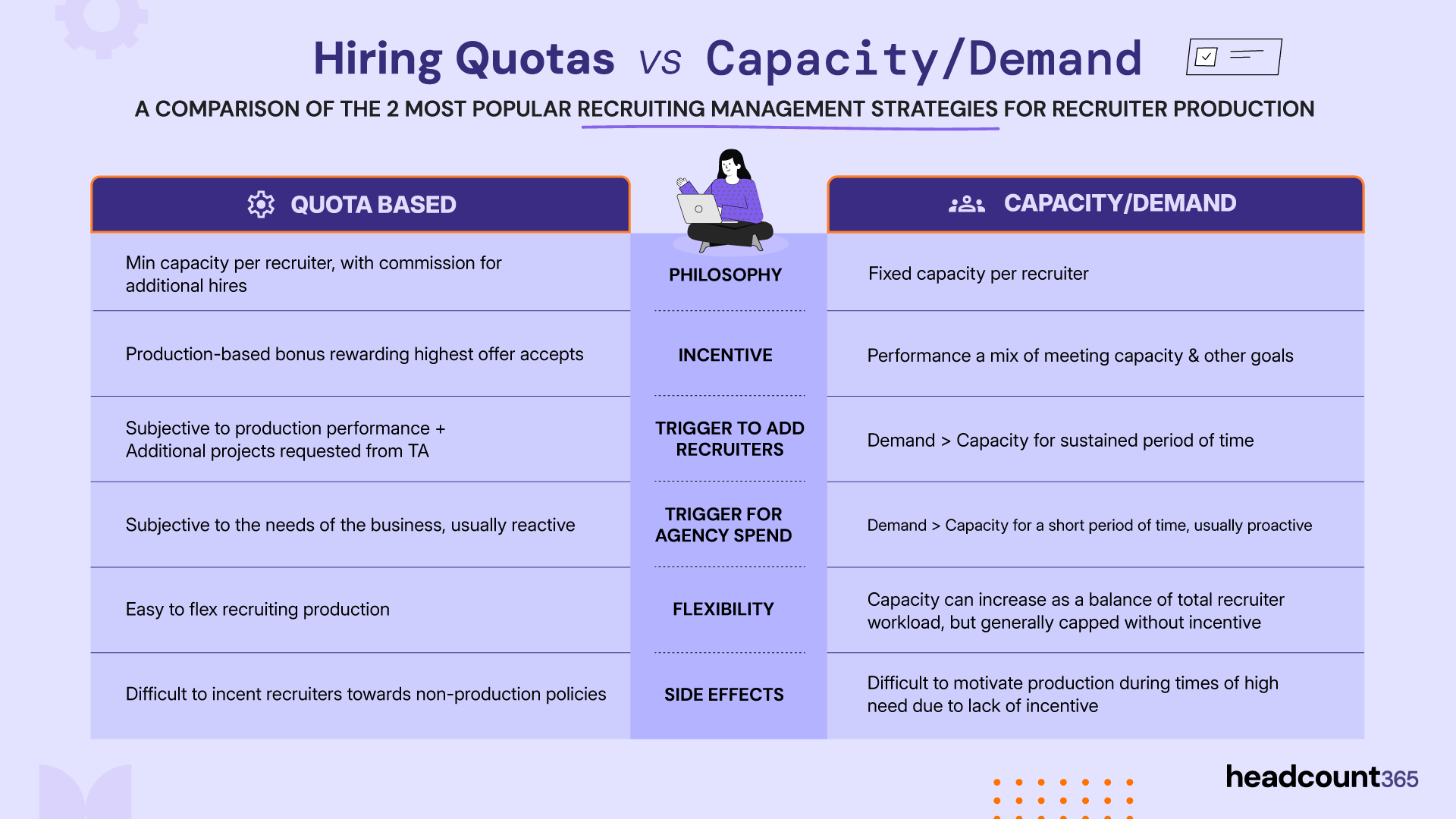Choosing a Recruiting Strategy: Capacity/Demand vs Hiring Quotas
Table of Contents
As recruiting leaders, your job is to create a repeatable, predictable hiring environment so the business can hit production goals. Executives need confidence in the recruiting service’s ability to fulfill the hiring demand, and there are 2 popular recruitment strategies to manage this process.
Capacity vs Demand Planning and Quota-based hiring
Capacity vs demand planning creates a static offer-accept maximum for recruiters, typically on a monthly basis. As demand exceeds capacity, additional resources are added to the recruiting team to meet increasing demand.
Quota-based hiring creates an offer-accept minimum for recruiters, and as demand exceeds capacity, there is incentive, often financial, for over production by recruiters.
Regardless of which recruiting strategy you leverage, the following are true.
On-time hires created predictable financial results
You need enough recruiting capacity to meet the hiring demand
There isn’t an unlimited recruiting budget. Financial efficiency matters
Hiring is a team effort. Recruiting teams can’t make hires without cooperation & understanding of the hiring teams they serve
Recruiting leader's performance is dependent on the degree of impact their team makes on achieving the business goals. Hyper-scalers will always have different hiring cultures than companies maintaining flat headcount.
Both Capacity/Demand Planning and Quota-Based Hiring are effective ways to run a recruiting department, but deciding which one is good for you is a mix of executive culture, speed of growth, and how dynamic your hiring requests are.
Today we’re going to dive into the pros and cons of each, to help you decide which strategy is best for you.
The Pros & Cons of Capacity vs Demand Planning Recruitment Strategy
Pros
The burden of recruiting production is shared outside the recruiting team, as hiring teams understand the context of your capacity before making requests
Adding recruiters is mathematic
Recruiting agency usage & budget planning are triggered by temporary spikes in demand against capacity
Actuals-to-goal reporting on capacity demand paints a clear picture of recruiting production performance against a standardized expectation
Easier to plan for non-production recruiting projects & activities
Cons
Inflexible to emergency-based hiring
Requires a maturity to headcount planning
Read more about headcount365’s built in Capacity/Demand Framework & reporting here
The Pros & Cons of Quota-Based Recruiting Strategy
Pros
Flexible to emergency hiring – whether you sign a new customer or deal with a high-priority backfill
Production incentive works. Production per recruiter is much higher on average in quota-based environments
Cons
The burden of recruiting production is centered around the ability of Recruiting to produce
There is no “top limit” of production to manage hiring team expectations or add more recruiters
Recruiting agency usage & budget planning can be viewed as a failure to produce
Actuals-to-goal reporting with quota-based hiring is less objective as there is flexibility to the goal
Non-production recruiting projects & activities are at risk during periods of high recruiting demand
Incentive to produce may conflict with compensation controls & cultural fit
Which Recruiting Strategy Is More Effective in Practice?
I’ve been a recruiter in both environments, and I know hands-on how each structure impacted the recruiting team & culture. In the early Uber days, we couldn’t be structured, so we used Quota-based recruitment strategy. We were growing so fast the recruiting team couldn’t keep up, so the incentive for over-production helped us deliver results, set the context for baseline production for future recruiting hires, and ultimately meet our scaling goals. That said, we introduced a ton of compensation inequality for similarly leveled roles, which promoted systemic inequalities in compensation that were painful to correct.
Around 2015, the recruiting team was in a place where we could introduce capacity vs demand planning to give the executives & boards a predictable production. These controls helped us create a more predictable relationship with finance, while delivering recruiting projects that added maturity to our brand and culture.
Every recruiting leader has to balance production, with the overarching talent brand & culture needed to ensure their business meets its target. Deciding which recruiting strategy is best for you is a function of planning maturity, scaling speed, recruiting budget availability, and requisite flexibility of the recruiting service to meet the needs of the business. Regardless of which you choose, headcount365 has built-in recruiting tools to help you achieve these goals.

